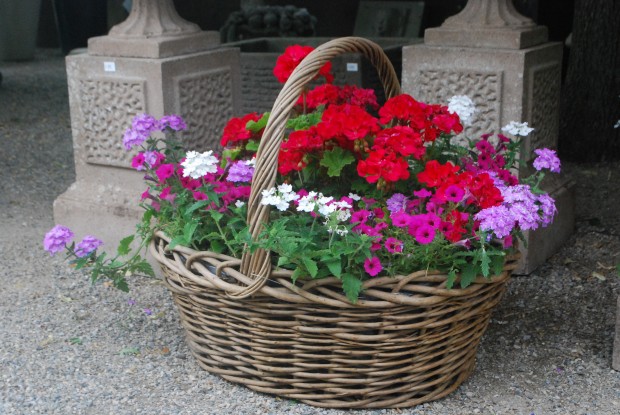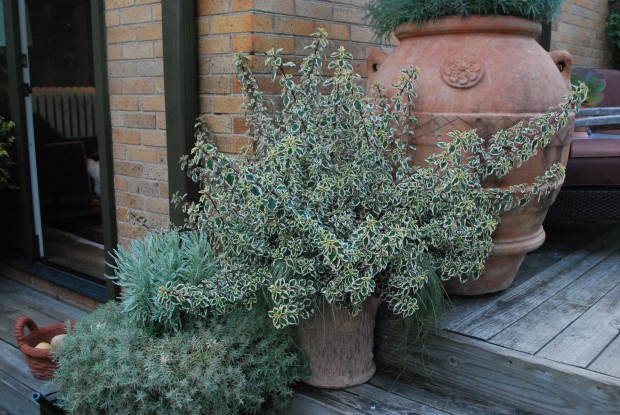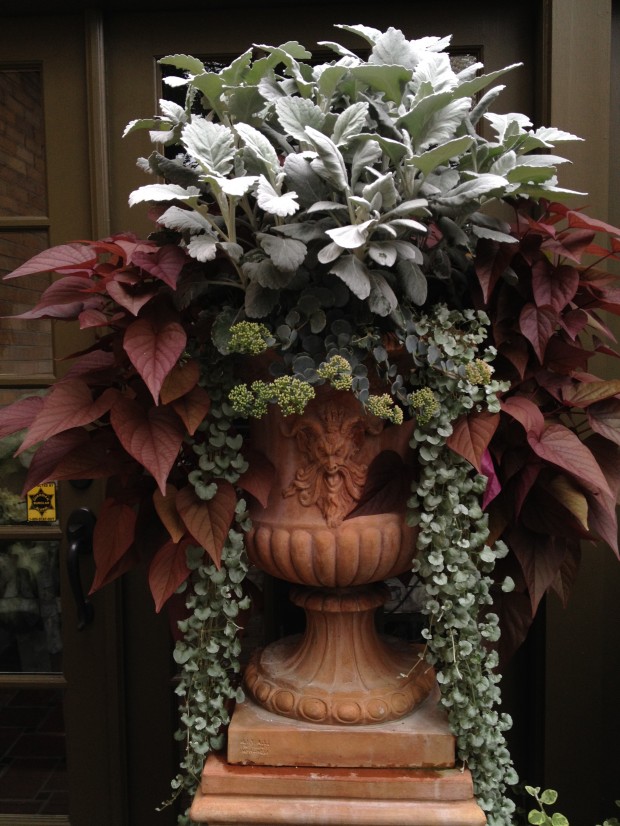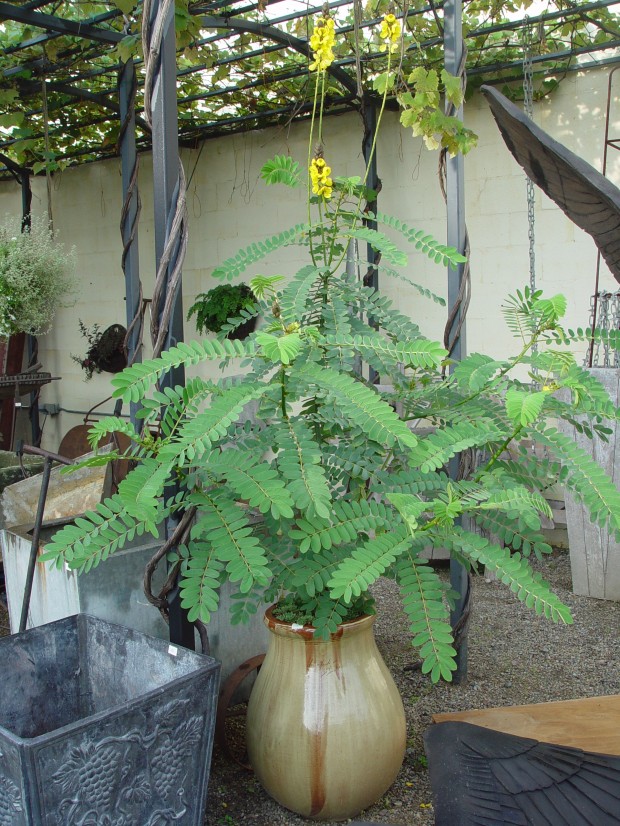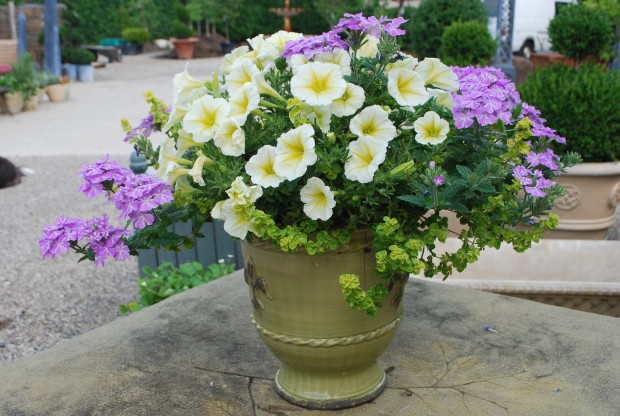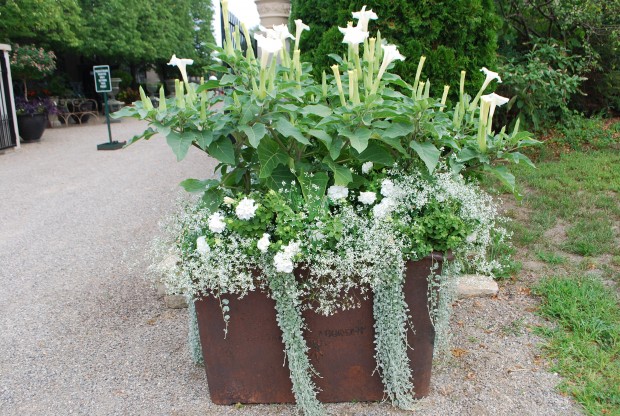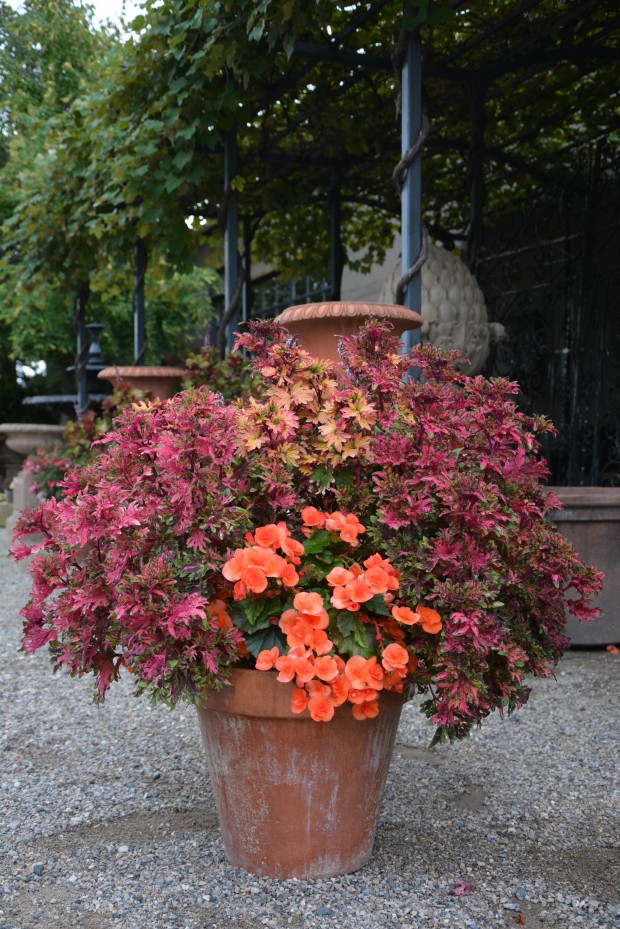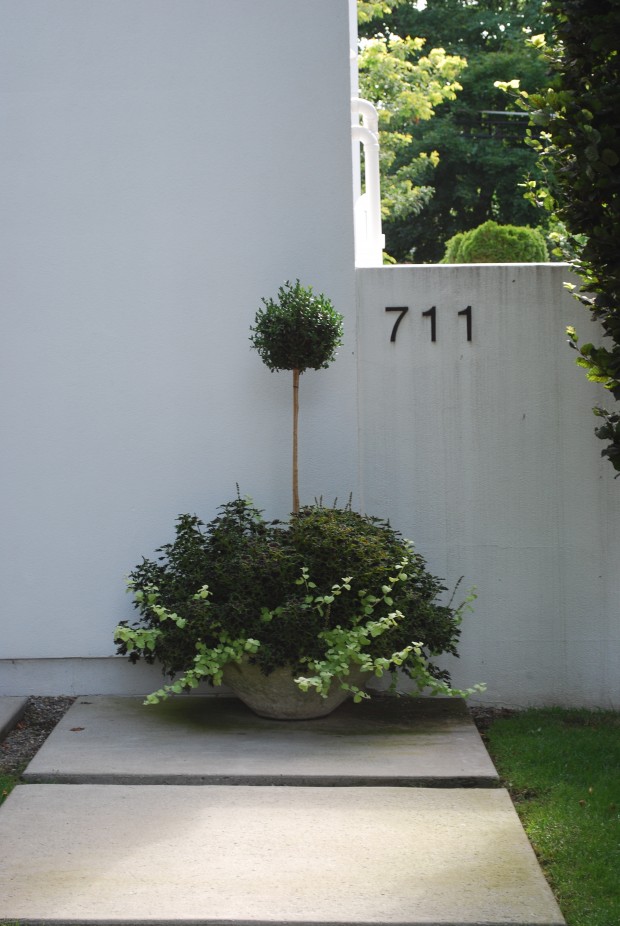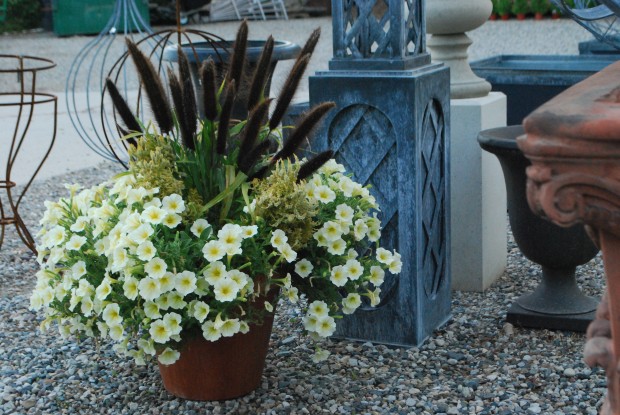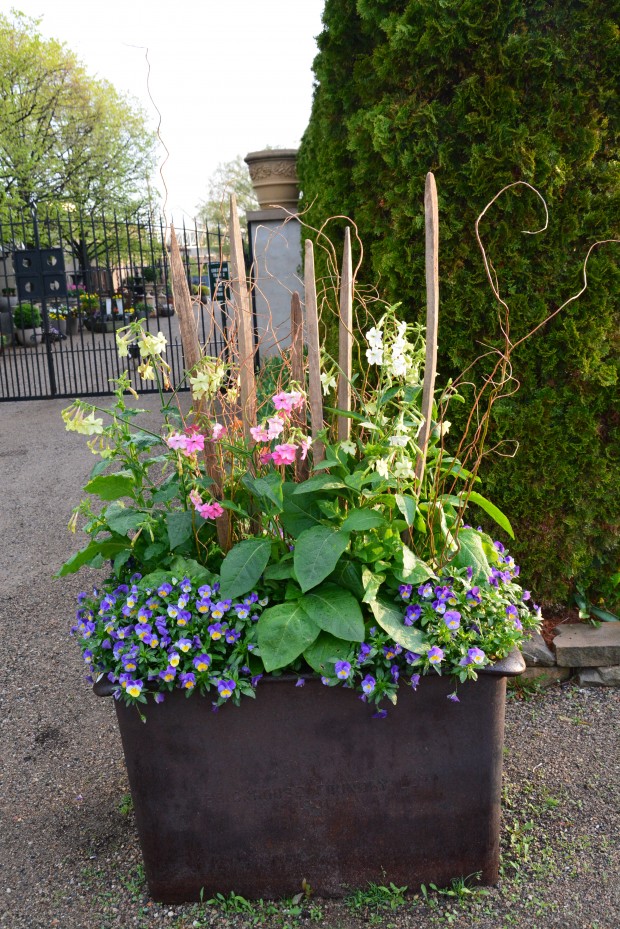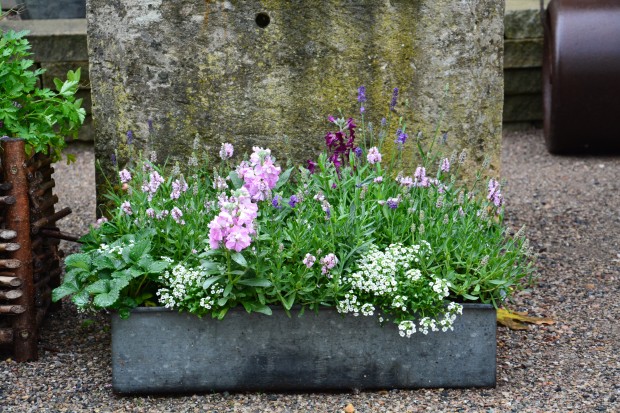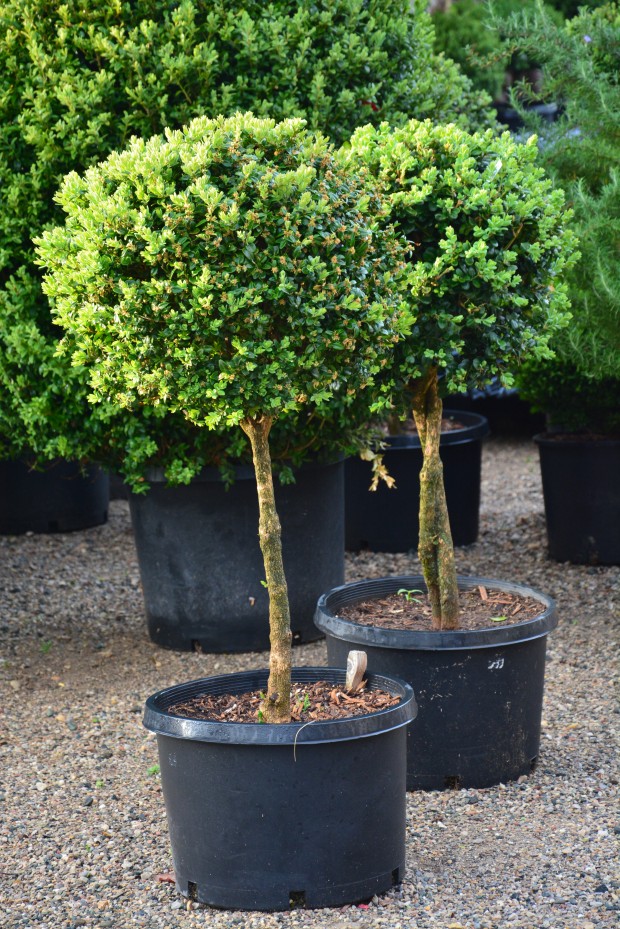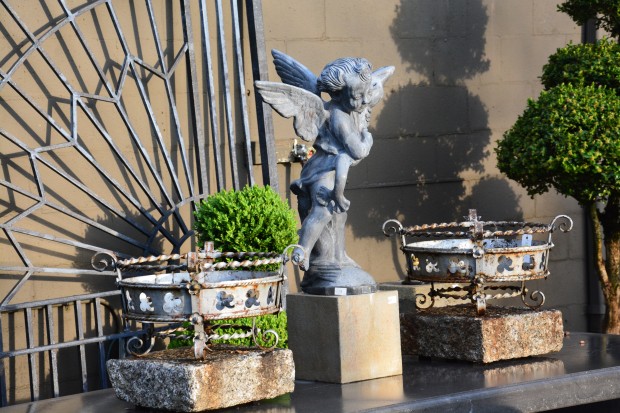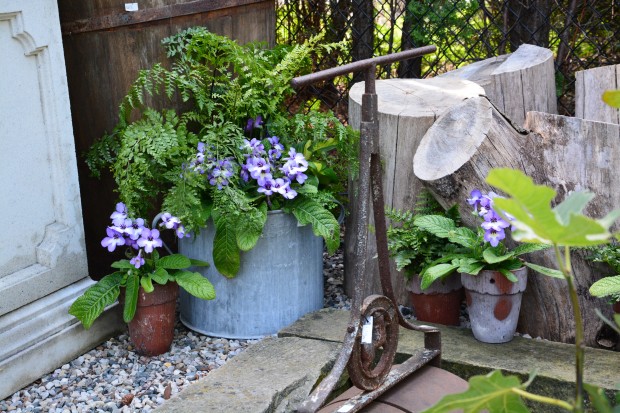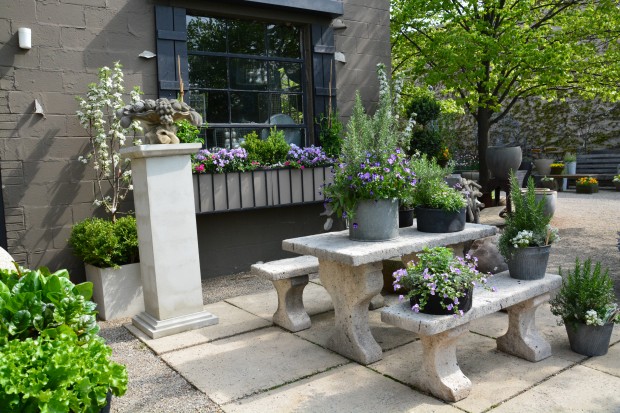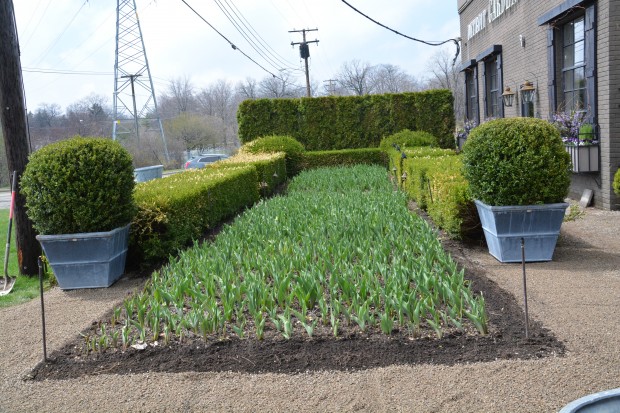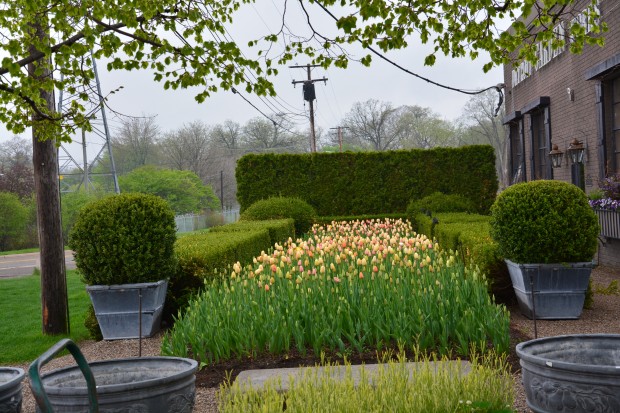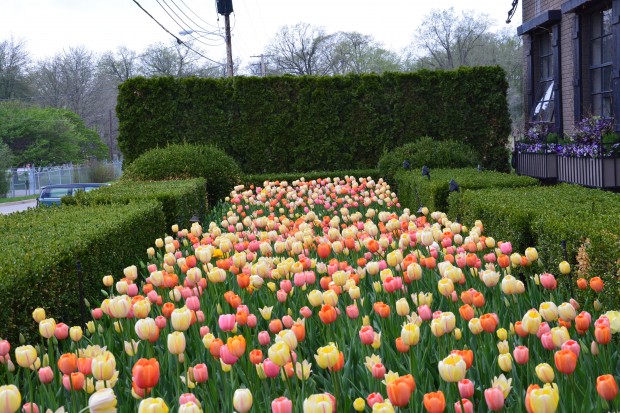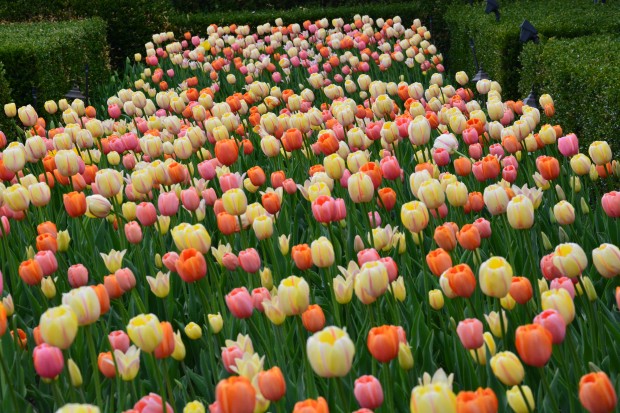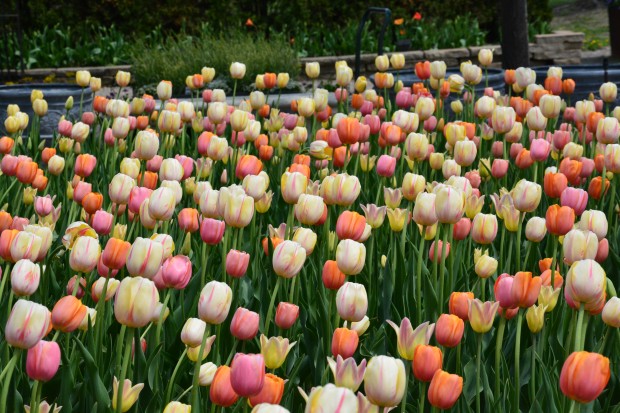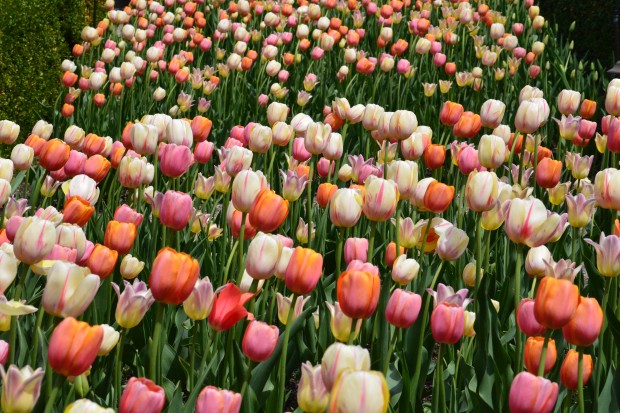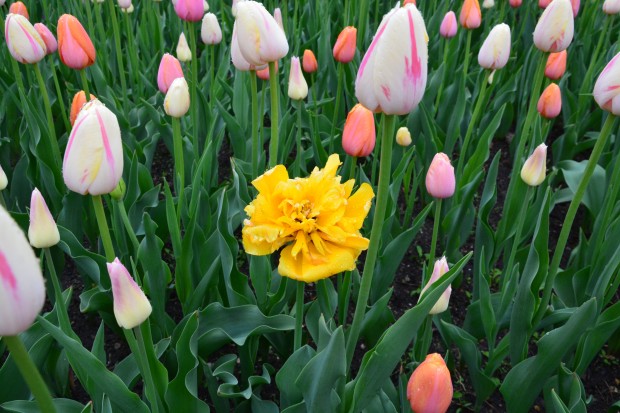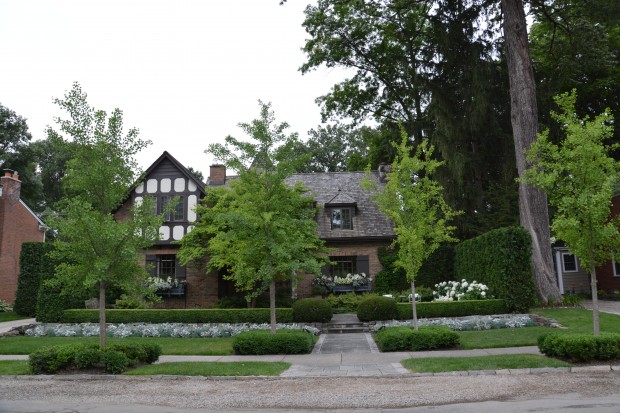 A small property is uniquely suited for the creation of a landscape that can be fully charged with an atmosphere and aura all its own. In a small space, every gesture is deliberate, apparent, and personal. Nothing escapes a keen eye. The scale of a small space is a scale a single person can easily become part of. The experience of a beautiful small landscape is compelling, as every element is geared towards interaction. A small space can be readily absorbed and savored. This landscape is about the relationships between shapes, both green and not. How the color of the roof, the window boxes, the blue stone walkway, and seasonal plantings is a cohesive visual discussion of color. The mix of materials is interesting, no matter the season. It could be seen in a matter of minutes, but many visitors told me they lingered there an hour or better, enthralled by the experience of it. Four gingkos, under planted with boxwood, frame the view to the window boxes, and gently guide visitors towards the front door, which is hidden from the street.
A small property is uniquely suited for the creation of a landscape that can be fully charged with an atmosphere and aura all its own. In a small space, every gesture is deliberate, apparent, and personal. Nothing escapes a keen eye. The scale of a small space is a scale a single person can easily become part of. The experience of a beautiful small landscape is compelling, as every element is geared towards interaction. A small space can be readily absorbed and savored. This landscape is about the relationships between shapes, both green and not. How the color of the roof, the window boxes, the blue stone walkway, and seasonal plantings is a cohesive visual discussion of color. The mix of materials is interesting, no matter the season. It could be seen in a matter of minutes, but many visitors told me they lingered there an hour or better, enthralled by the experience of it. Four gingkos, under planted with boxwood, frame the view to the window boxes, and gently guide visitors towards the front door, which is hidden from the street.
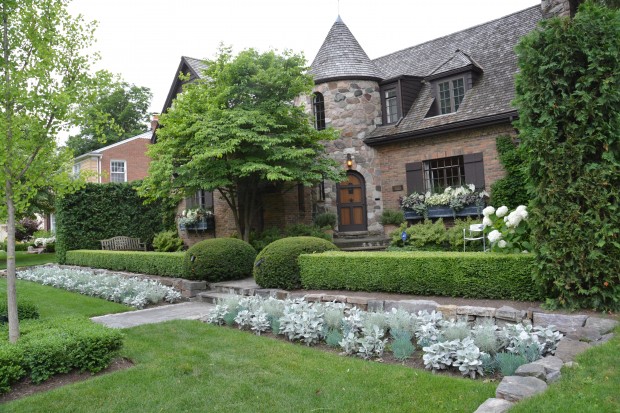 Large landscapes and parks can be awe inspiring. Even overwhelming. Large landscapes can be exhilarating. If poorly done, they can be pushy, boring, or tiring. Some large landscapes are designed such that only one area is experienced at a time. This in recognition that overscaled landscapes can be as easily off putting and impersonal as they are grand. A beautiful small landscape is an opportunity to intimately become part of, and experience the garden. Small spaces can be difficult to design edge to edge, and floor to ceiling, but the rewards are great. In this front yard landscape, the change of levels creates a three dimensional sculptural quality which can be enjoyed in every season. The low wall that traverses the width of the property is a visually friendly way of differentiating public part of the landscape from the front door. The unusual placement of this front door on an angle from the street makes the front door garden more private, in a very modest way. The boxwood hedges which terminate in yew spheres is a transition space, an exterior foyer for the front door, if you will. The natural growing multi stemmed dogwood and gingkos contrast with the precisely trimmed arborvitae and boxwood.
Large landscapes and parks can be awe inspiring. Even overwhelming. Large landscapes can be exhilarating. If poorly done, they can be pushy, boring, or tiring. Some large landscapes are designed such that only one area is experienced at a time. This in recognition that overscaled landscapes can be as easily off putting and impersonal as they are grand. A beautiful small landscape is an opportunity to intimately become part of, and experience the garden. Small spaces can be difficult to design edge to edge, and floor to ceiling, but the rewards are great. In this front yard landscape, the change of levels creates a three dimensional sculptural quality which can be enjoyed in every season. The low wall that traverses the width of the property is a visually friendly way of differentiating public part of the landscape from the front door. The unusual placement of this front door on an angle from the street makes the front door garden more private, in a very modest way. The boxwood hedges which terminate in yew spheres is a transition space, an exterior foyer for the front door, if you will. The natural growing multi stemmed dogwood and gingkos contrast with the precisely trimmed arborvitae and boxwood.
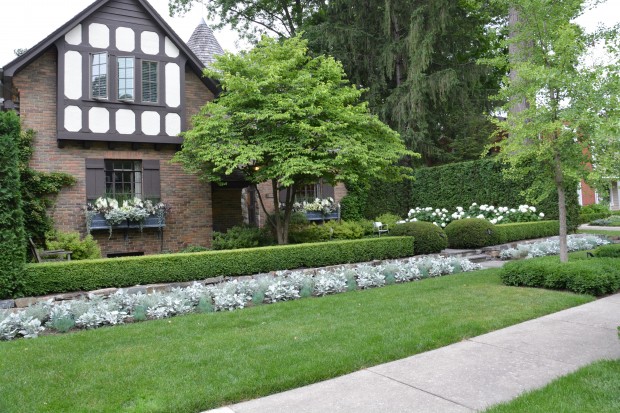 In the summer, a very beautiful low stone wall is obscured by a seasonal in ground planting. This planting of blue chalky fingers succulents, helichrysum icicles and cirrus dusty miller is my most favorite choice ever. The cool color is crisp, and echoes the color of the stone and the steel of the window boxes. In the winter, that wall is an architectural feature that is friendly to the style and period of the house. The upper level features a vintage wood bench at one end, and a modern bistro table and stainless steel chairs at the opposite end. I like the nod to the period of the house, and the corresponding nod to my client’s more modern taste. In a small space, there is the opportunity to create an interesting tension which comes from the juxtaposition of one aesthetic, and another.
In the summer, a very beautiful low stone wall is obscured by a seasonal in ground planting. This planting of blue chalky fingers succulents, helichrysum icicles and cirrus dusty miller is my most favorite choice ever. The cool color is crisp, and echoes the color of the stone and the steel of the window boxes. In the winter, that wall is an architectural feature that is friendly to the style and period of the house. The upper level features a vintage wood bench at one end, and a modern bistro table and stainless steel chairs at the opposite end. I like the nod to the period of the house, and the corresponding nod to my client’s more modern taste. In a small space, there is the opportunity to create an interesting tension which comes from the juxtaposition of one aesthetic, and another.
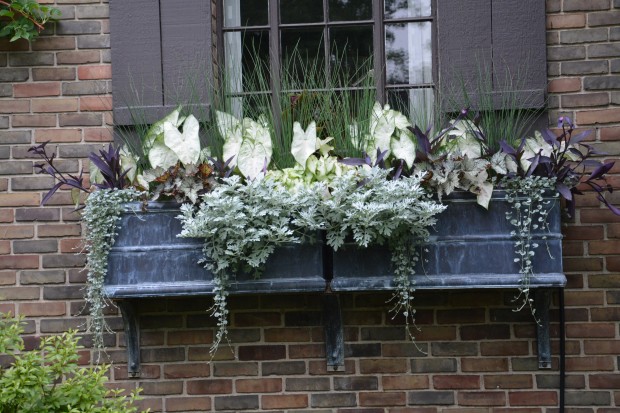 The window box is a combination of plants whose forms and color are not the usual. To my eye, the planting is both sophisticated and unusual. This has everything to do with the taste of my clients. I have worked for them for years, and the relationship which has come out of that association shows.
The window box is a combination of plants whose forms and color are not the usual. To my eye, the planting is both sophisticated and unusual. This has everything to do with the taste of my clients. I have worked for them for years, and the relationship which has come out of that association shows.
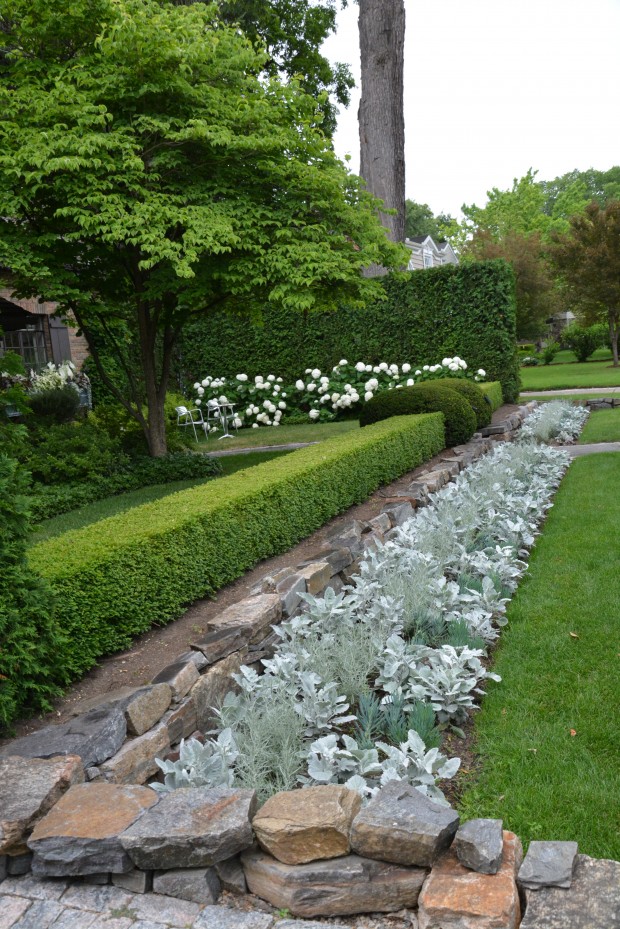 The blue gray annual border is equally unusual, and striking. It is in concert with the boxwood hedge, and such in contrast to the loose habit of the Annabelle hydrangeas.
The blue gray annual border is equally unusual, and striking. It is in concert with the boxwood hedge, and such in contrast to the loose habit of the Annabelle hydrangeas.
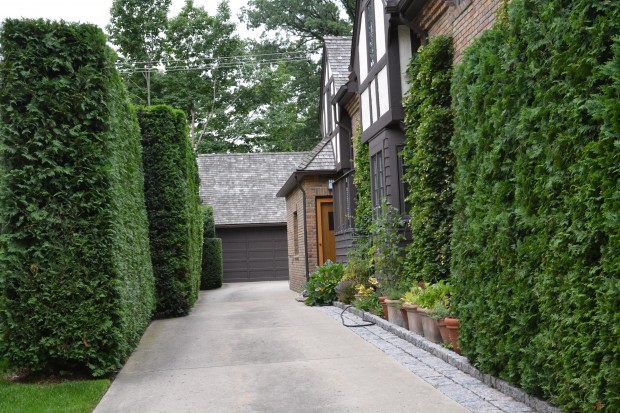 The driveway garden is home to a number of terra pots planted with vegetables and herbs-all appropriately placed close to the kitchen door. The stepped evergreen screening limits the view of the garage from the street.
The driveway garden is home to a number of terra pots planted with vegetables and herbs-all appropriately placed close to the kitchen door. The stepped evergreen screening limits the view of the garage from the street.
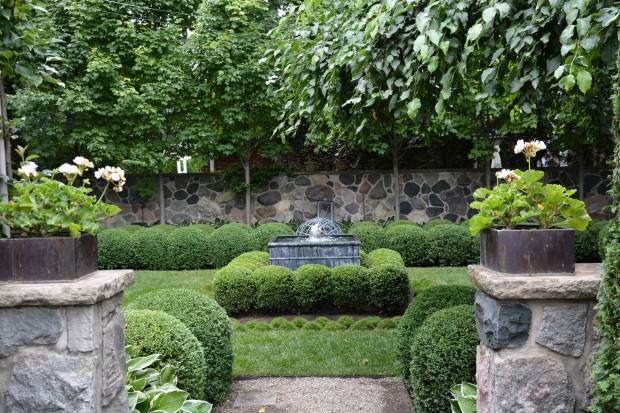 A low granite wall capped in limestone separates the driveway area from the rear yard proper. A higher wall of the same material and design at the far side is a beautiful feature of this yard. The planting of columnar red maples in front of this wall is purposeful. The narrow gray trunks do not obscure the wall from view. The canopy of the maples adds another, taller layer of screening from the neighboring garage.
A low granite wall capped in limestone separates the driveway area from the rear yard proper. A higher wall of the same material and design at the far side is a beautiful feature of this yard. The planting of columnar red maples in front of this wall is purposeful. The narrow gray trunks do not obscure the wall from view. The canopy of the maples adds another, taller layer of screening from the neighboring garage.
 Though the rear yard is a rectangle, the landscape is a celebration of the square established by a square fountain in the center, a square picture frame of lawn, and a square arrangement of Winter Gem boxwood. In order to maintain that square, a double row of boxwood was planted on the north and south side, and a single row of boxwood on the east and west side. Behind the boxwood to the south, a pair of pear espaliers are under planted with a white variegated hosta. The pears provide fruit, and screening of the service area between the wall and the garage. Each boxwood is individually pruned into a spherical shape, courtesy of Melissa and her crew from M and M Flowers. Those round shapes, and the round shapes of the Irish moss compliment and contrast with the dominant square geometry. The dirt space between the fountain boxwood and the Irish moss is deliberate. Every element of that fountain centerpiece has room to breathe.
Though the rear yard is a rectangle, the landscape is a celebration of the square established by a square fountain in the center, a square picture frame of lawn, and a square arrangement of Winter Gem boxwood. In order to maintain that square, a double row of boxwood was planted on the north and south side, and a single row of boxwood on the east and west side. Behind the boxwood to the south, a pair of pear espaliers are under planted with a white variegated hosta. The pears provide fruit, and screening of the service area between the wall and the garage. Each boxwood is individually pruned into a spherical shape, courtesy of Melissa and her crew from M and M Flowers. Those round shapes, and the round shapes of the Irish moss compliment and contrast with the dominant square geometry. The dirt space between the fountain boxwood and the Irish moss is deliberate. Every element of that fountain centerpiece has room to breathe.
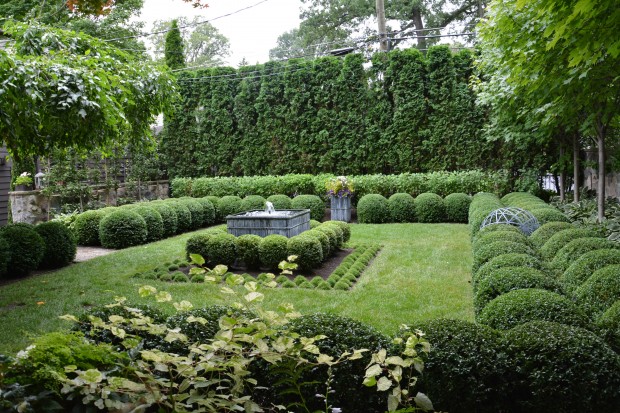 On the west side, a hedge of arborvitae screen the property behind, the phone pole, and the electric lines. Limelight hydrangeas are planted as a hedge between the arborvitae and the boxwood. The limelights are limbed up to just below the height of the boxwood. The foliage of the Limelights do not interfere with the growth and health of the boxwood. A hedge of topiary form hydrangeas helps keep both the hydrangeas and the boxwood happy – in a small space. Underplanting arborvitae is always a good idea. With age, they thin out at the bottom. An old crabapple visible at the far left of this picture is kept trimmed up to permit a view through from the house.
On the west side, a hedge of arborvitae screen the property behind, the phone pole, and the electric lines. Limelight hydrangeas are planted as a hedge between the arborvitae and the boxwood. The limelights are limbed up to just below the height of the boxwood. The foliage of the Limelights do not interfere with the growth and health of the boxwood. A hedge of topiary form hydrangeas helps keep both the hydrangeas and the boxwood happy – in a small space. Underplanting arborvitae is always a good idea. With age, they thin out at the bottom. An old crabapple visible at the far left of this picture is kept trimmed up to permit a view through from the house.
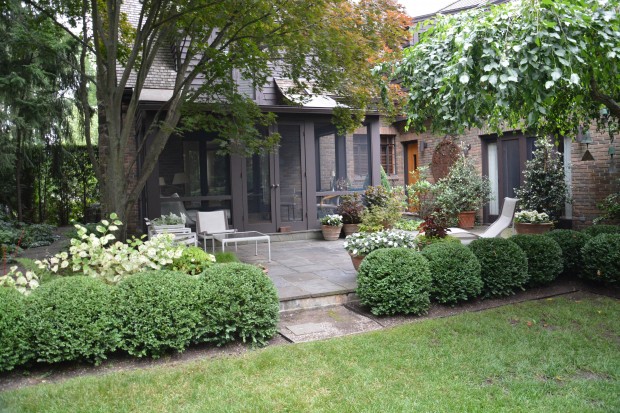 A rear terrace with furniture and container plantings, and a screened porch – both of which has been in place many years – are places to relax, and be part of the landscape.
A rear terrace with furniture and container plantings, and a screened porch – both of which has been in place many years – are places to relax, and be part of the landscape.
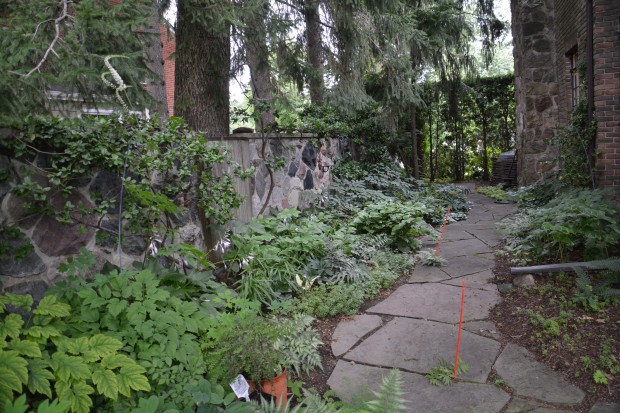 A wild garden on the north side of the back yard is full of hellebores, snakeroot, hosta, solomon’s seal, european ginger and ferns, among other things – this a much more relaxed ode to shade. This garden was on our recent garden tour to benefit the Greening of Detroit. I was pleased about how many people truly enjoyed it. The best part of this landscape-all of the care my clients lavish upon it. Every detail is of concern. Small properties help make a lavish hand possible, and visible.
A wild garden on the north side of the back yard is full of hellebores, snakeroot, hosta, solomon’s seal, european ginger and ferns, among other things – this a much more relaxed ode to shade. This garden was on our recent garden tour to benefit the Greening of Detroit. I was pleased about how many people truly enjoyed it. The best part of this landscape-all of the care my clients lavish upon it. Every detail is of concern. Small properties help make a lavish hand possible, and visible.
